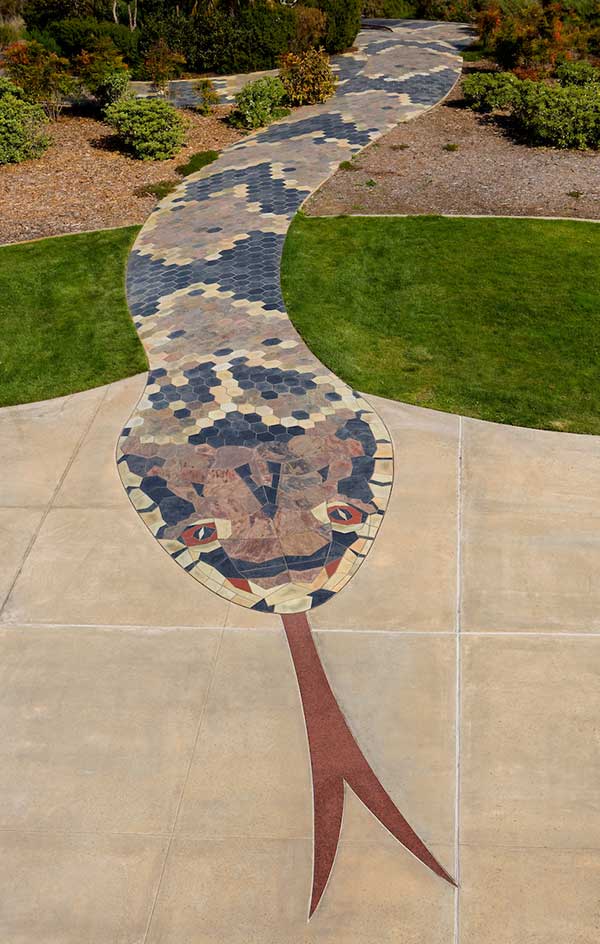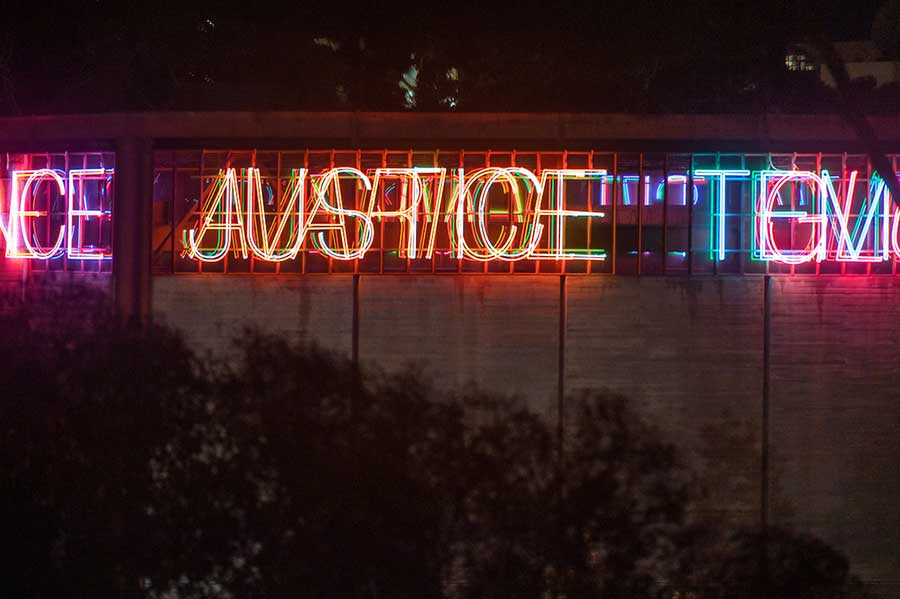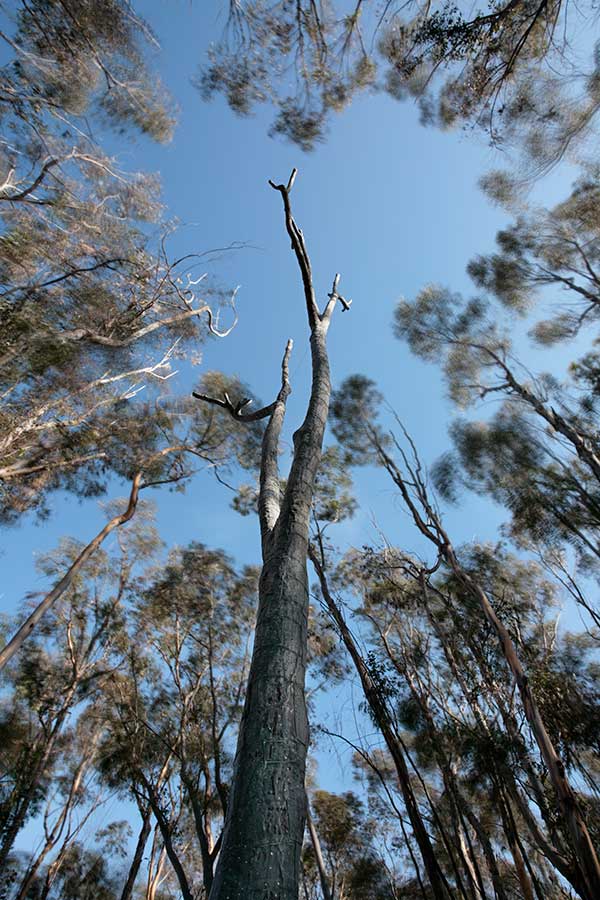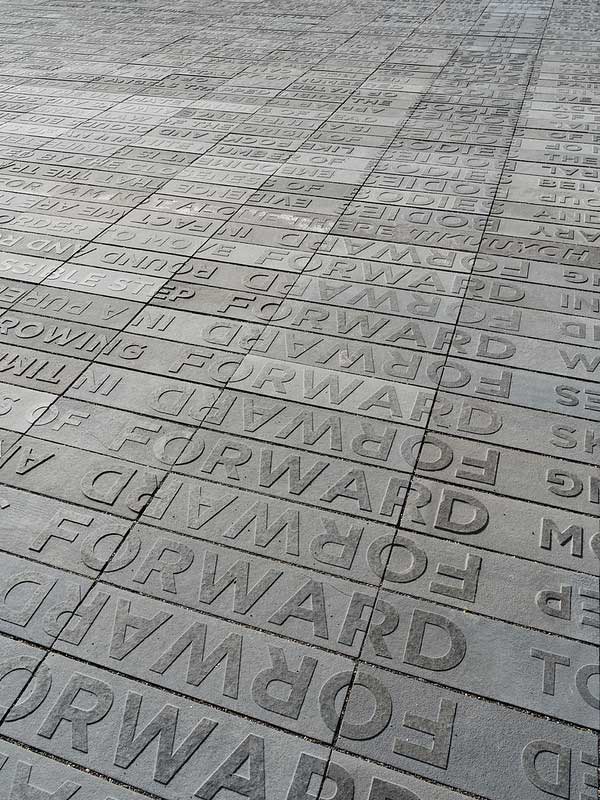By:
- Erika Johnson
Published Date
By:
- Erika Johnson
Share This:
Stuart Collection Welcomes Jessica Berlanga Taylor as New Director
Jessica Berlanga Taylor, newly appointed director of the Stuart Collection. Photo by Erik Jepsen/University Communications.
As you crisscross the campus on your way to class, or chat with a colleague en route to a meeting, you may stumble upon a treasure hidden in the trees. There are more than 20 artworks infused into the landscape of UC San Diego, commissioned as part of the renowned Stuart Collection. This spring, the collection welcomed a new creative leader: curator, writer and art project manager Jessica Berlanga Taylor. As director of the Stuart Collection, she is responsible for the growth and conservation of the diverse works, from conceptualization to ongoing conservation of existing sculptures.

Artist Alexis Smith completed her work “Snake Path” in 1992, a winding 560-foot-long, 10-foot-wide footpath in the form of a serpent. Photo by Philipp Scholz Rittermann.
A bicultural and bilingual art professional, Berlanga Taylor has curated numerous exhibits and commissioned more than 40 works of art, 11 of which were created for public spaces in Mexico City. She has led the design and implementation of education projects, seminars and workshops for a wide array of audiences including students and emerging artists. In addition to her extensive art curation work, Berlanga Taylor has also edited, co-authored and published three books and numerous articles and essays, including a comprehensive survey of 20 years of contemporary art in Mexico.
Now more than two months into her role, Berlanga Taylor is energized by the opportunity to engage new artists, spark conversations about important topics and extend the collection into the community. She shares with us her preliminary plans to promote education, strengthen the university’s position as an arts destination and her early exposure to the allure of museums.
Q. What attracted you to the role and how will you help shape the campus into an arts destination?
A. I was interested in the role of director of the Stuart Collection for the opportunity to take care of a legacy while at the same time embracing opportunities for growth. It’s unique to have an open air museum that both mirrors and elevates the excellence of the intellectual and cultural life of a campus by commissioning art of its time. This aligns with one of my key goals: to help realize the vision of Chancellor Khosla to transform UC San Diego into an arts destination. This will enable us to create deeper connections with local, national and international organizations. To me, the crucial aspect of public space is where democracy is created and debated and challenged. We are creating the dialogues that we need to have in order to be able to face the complexity of the times we are living in.

The flashing neon work, titled Vices and Virtues, was created in 1988 by artist Bruce Nauman. Photo by Erik Jepsen/University Communications.
Q. Beyond curating more art for the collection, how would you like to engage communities in learning about the works?
A. Apart from curatorial work, I love creating public programs to further education in a different way. The first step in achieving this is understanding the use that audiences assign an artwork and how they engage with it. I’d like to hold more space for debate and expression, widening the conversation about the themes of the artwork and how these might be relevant to what students are studying or researching. From there, I would love to complement arts education already happening on campus, such as in the MFA and visual arts programs. In addition, it would be great to infuse storytelling and performative arts to broaden the presence of the artwork both on and off campus. The ultimate goal is to inspire a sense of wonder and connection by offering a range of artistic experiences people can have throughout the university.
Q. The collection contains a range of voices, mediums and meanings. How will you continue to grow the diversity of artists included?

Terry Allen’s “Trees,” were created in 1986 and comprise three trees–a musical tree, a literary tree and a silent tree. Photo by Philipp Scholz Rittermann.
A. I see the immediate future of the Stuart Collection as strengthening and expanding its engagement with the communities we serve by positioning diversity at the center of the work we do. This can involve diversifying the portfolio of artists we invite for commissions, the issues and themes that we address, the sites where sculptures are placed and communities we collaborate with on and off campus. We can create very rich conversations right from the beginning, starting with partnering with the Office for Equity, Diversity and Inclusion to amplify the efforts that the university is already making. I’d like to explore how we can create meaningful experiences through art for audiences that come from all sorts of experiences of life. It's exciting the way that art can forge deep connections between people and build resilience among communities.
Q. What do you enjoy most about curating?
A. Curating is about creating connections. I love getting involved with artists right from the beginning. Though not an artist myself, I do like to participate in the co-creation of commissioned artwork. I'll help the artist come up with concepts, make decisions and begin developing the work. And doing this at UC San Diego is very exciting because there is a fantastic ecosystem of intellectual work happening here. Given the ethos of experimentation and innovation, we can push boundaries in what we commission and how we engage with people.
Q. The entire 1,200-acre campus is available for commissions. What makes this a unique opportunity?

The collection’s newest piece, titled CONCORDANCE, completed in 2022 by artist Ann Hamilton. Photo by Philipp Scholz Rittermann.
A. I love site specificity because it's all about understanding people and places, creating a sense of belonging, and revealing the importance of a particular location. For the past 15 years I have worked on commissions for public spaces, generating creative ideas about how to engage with different audiences in Mexico City, together with artists from different parts of the world. It’s important to help the artist understand the context of their work, as well as challenge them to go further. Perhaps they have always wanted to experiment with a certain material or address a particular issue. Being able to come up with fresh ideas and get immersed in the context of a site is exciting.
Q. When did you realize that you wanted to pursue a career in the arts?
A. I have always been surrounded by art. My father is a photographer and his studio and labs were in our home. He worked with a lot of dancers, painters and sculptors, so the space was always buzzing with artists coming and going. I was also immersed in a bicultural lifestyle–my father is Mexican and my mother is British. They both intentionally exposed my brother and I to the amazing intellectual and artistic history of Mexico, Latin America and Europe. I also recall an awakening happening when I was 13 and my mother took me to the National Gallery in London. I still remember the jaw-dropping moment of walking into the Paul Cézanne exhibit; I suddenly became aware of the brilliance behind art.
Share This:
Stay in the Know
Keep up with all the latest from UC San Diego. Subscribe to the newsletter today.



